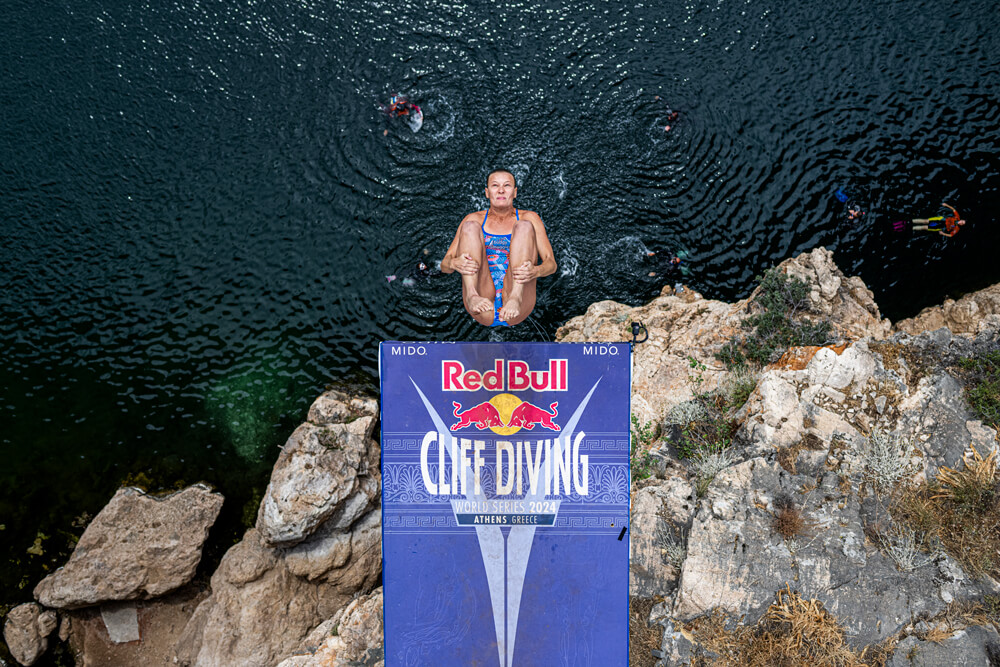VERY HIGHS AND LOWS
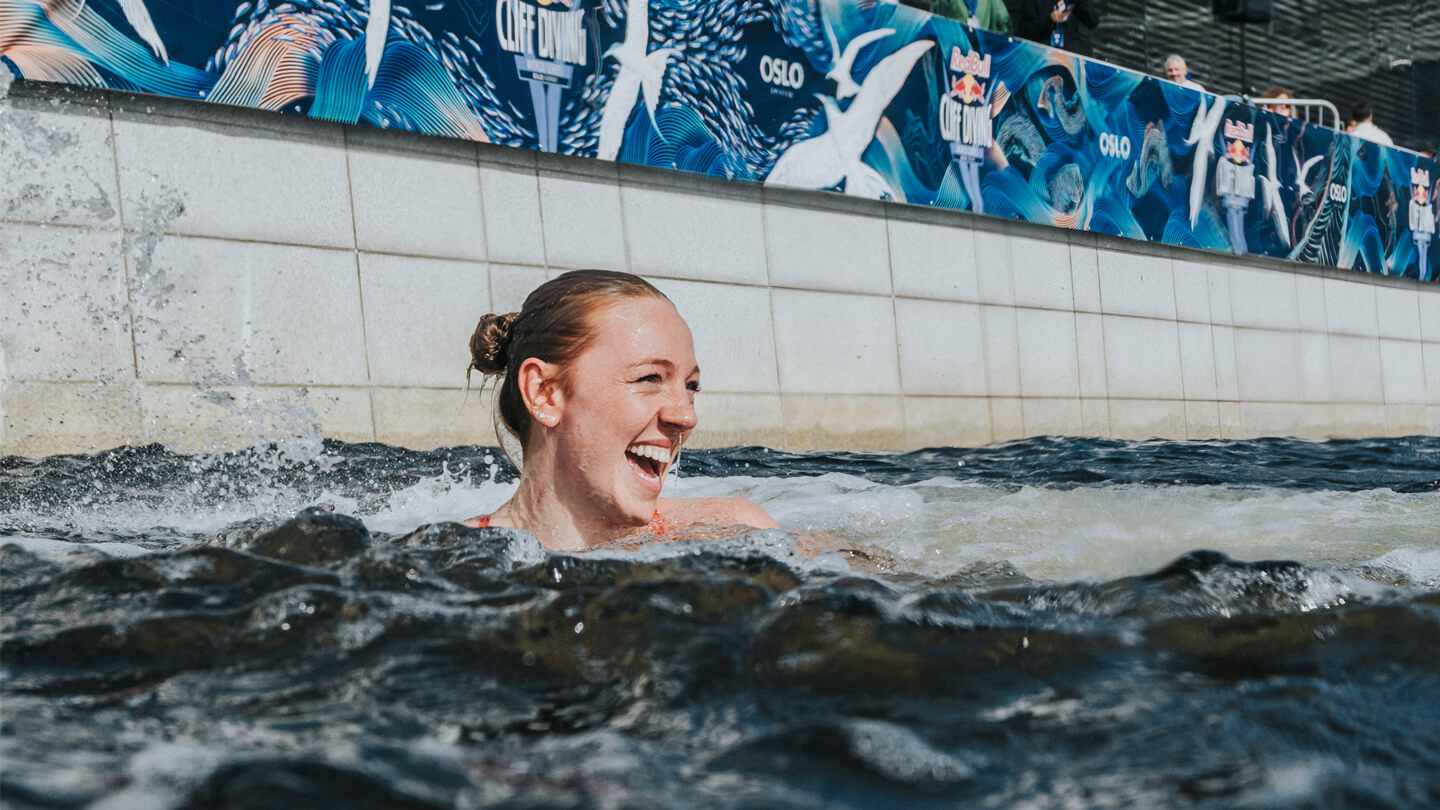
Editor’s Note: The following story deals with disordered eating, and may be distressing for some readers.
M olly Carlson rappelled down a cliff in Northern Ireland wearing a safety harness, a pair of white Crocs and a colourful bathing suit with a red maple leaf on it. When she arrived at a small rock ledge jutting out from the cliff, about 21 metres above the Atlantic Ocean, she steadied herself on it and removed her harness, then threw her Crocs into the water below.
Less than a minute later, the Canadian raised her arms above her head, held them there for a few beats and then jumped, tucking into two front somersaults before straightening into the pike position for a half-twist and hitting the Atlantic with a feet-first splash. Carlson broke the surface with a smile and let the safety divers surrounding her know she wasn’t injured. On her Sea-Doo ride back to shore, she waved and cheered. Five judges in a nearby boat held up scores for her dive, the highest an eight out of 10. The total score put her in third place halfway through this event, the fourth stop on the Red Bull Cliff Diving World Series.
Done competing for the day, the 25-year-old from Thunder Bay, Ont., passed through security wearing a grey sweatsuit with “Canada” written on the back, and that’s when the screaming started. A crowd of people waited to meet her, some crying or shaking or doing both at the sight of Carlson. Her mom, Kathleen Trivers, and stepdad, Keith Shular, realized as they stood among the 100 or so fans that they weren’t just proud parents here in Northern Ireland, they were also bodyguards. As soon as Carlson got in front of the crowd, the conversations, selfies, hugs and autographs were nonstop. At the back of the line that eventually formed was a young Irish woman named Fionnuala who’d driven four hours to thank Carlson because she’d been at a very low point when she stumbled across the diver on the Internet. “You saved my life,” she told Carlson.
Carlson didn’t make a fan feel that way with high dives alone, it also took bravery of a different sort. She packs a truly unique one-two punch: among the world’s best in a gutsy sport, she’s also willing to show her lowest and most vulnerable moments while she navigates a career that brings her both joy and panic attacks. Her unfiltered honesty and #BraveGang movement have earned her a social media following in the millions, which has in turn exposed countless people to cliff diving for the first time. And so even as she continues to chase her toughest competitor for the Series’ top spot, Carlson has already become the face of the sport.
Next week, the Brave Gang leader will take on a new experience: competing at home as the Red Bull Cliff Diving Series lands in Montreal, its first-ever Canadian stop. Winning there would be “magic,” she says, but it will also require her to be perfect from the platform — and to once again face the pressure to be flawless, a feeling inextricably tied to both her greatest triumphs and darkest moments.
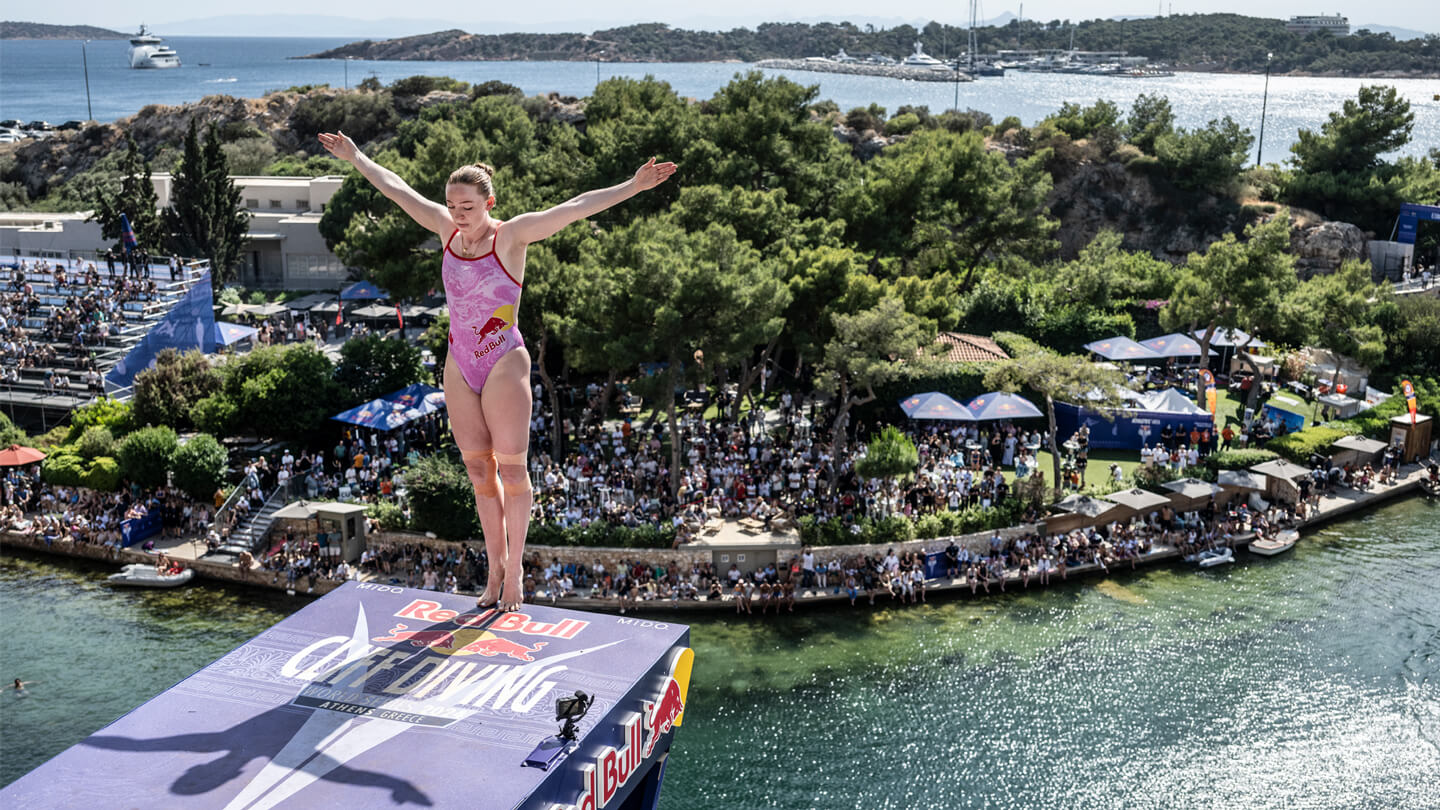
T rivers, Carlson’s mom, is a self-described “hoarder,” so she’s pretty sure she still has this one picture Molly drew when she was four or five. It’s a self-portrait, Carlson as a stick figure standing at the top of a podium with the Olympic rings behind her and a medal around her neck. “She really wanted to be an Olympian,” Trivers says, though at that point, Carlson hadn’t settled on a sport.
She started gymnastics when she was seven at the Canada Games Complex in Thunder Bay, and also found herself frequently at the pool there since her older sister, Megan, was a swimmer. When the girls went to summer camp at the Complex, Carlson discovered diving. She started on the 3-m. springboard at eight and by nine she wanted to join the older divers on the 10-m. platform. “Mom, that looks absolutely insane, but there’s something in my gut telling me I absolutely have to do it,” Carlson remembers telling “Mama Kitty,” her nickname for her mom. Trivers replied: “Please no.”
Soon after that exchange, Carlson dove off that tower for the first time. “I wanted to do it over and over again,” she says. “It was this moment of free falling that I was like, this is almost addicting — the way that bravery is addicting, you know?”
Trivers had both of her daughters when she was still a teenager, and she and their dad, Jason, separated when Carlson was in diapers. Money was always tight, so Carlson had to choose one sport to focus on. She opted for diving since she figured it was her best shot at the Olympics.
Success hit right away. She won her first national medal at age 9; made her first junior national team and qualified for the Pan American Junior Games a year later. She won her first Pan Am junior title at 15 and at 16 competed in the Youth Olympics and made her first world championship final. But by then, Carlson’s approach to diving had changed. “My joy slipped into, ‘This is more serious, I need to be perfect all the time if I want to keep making national teams,’” she says. “I never felt like I was enough.”
That year, a national team coach told her she was “too fat” to be an Olympian. “I thought the only way I could also do lots of flips and keep up with the other girls was to get skinnier,” says Carlson, who at five-foot-nine was also much taller than her teammates and competitors. So, she sought to change her body.
“Molly was told she’d never be an Olympian and that was it,” says Trivers, who’s quick to note that apart from the one coach, the diving community was supportive. “That sent her over the edge.”
In the lead-up to Canada’s 2016 Olympic diving trials, the 16-year-old Carlson developed a severe eating disorder. From Monday through Friday, the days she had to be training in a bathing suit, she limited herself to just 300 calories a day. She’d throw the breakfasts Trivers made her on the floor. She’d eat three almonds for lunch. “Then on Friday nights, I’d binge everything I could see because I wasn’t going to wear a swimsuit for two days,” she says. “It was terrifying, and then I’d go back to this restriction for five days of practice. No one can train 30 hours a week on 300 calories a day. No one can live on 300 calories a day. It was so brutal. I was truly starving myself as a teenager and then somehow also trying to be the best in the country. And those two things did not go hand-in-hand.” Carlson broke a wrist and suffered repeated sprains in part because her body was so fragile.
At 17, Trivers and Carlson moved to Toronto for her Grade 12 school year so she could train with the national team at the Toronto Pan Am Sports Centre in the lead-up to Olympic trials. That’s when Trivers started to notice how thin Carlson was getting, that her hair was falling out, that she was constantly tired and irritable. “All the cues of an eating disorder,” she says. “It was really hard. I remember being emotionally distraught, not being able to help her as a parent.”
Carlson was so focused on her Olympic dream that she wouldn’t accept help. And then she came up short, placing fourth at trials. “When she didn’t make the team, she felt like her entire life was over — it was crushing, like, she wanted to die,” Trivers says, her voice shaking at the memory. “She really felt like she was worth nothing because she didn’t make this team.”
Carlson wanted to quit diving, but after taking a week to think, working through her feelings by writing in her journal, she decided to stick with the sport but not the national team program. Instead, she would go to college and be an NCAA diver.
The decision brought an important realization. “I was suffering for a year going into that Olympic trials, and I thought the only thing that mattered in life was becoming an Olympian,” she says. “But then I was fourth at trials, and eventually it was this moment of clarity like: ‘Oh my gosh, I need help.’ Not making that team was by far the best thing that could have ever happened to me. It was almost like all the pressure was off and I could enjoy my life again.”
Carlson opened up to her mom about her eating disorder, her obsession with perfection, her body dysmorphia. “As soon as I did that, my life truly changed,” she says.
She started at Florida State University in September 2016, working with coach John Proctor. In four years there, Carlson was a three-time All-American and ACC Diver of the Year. She learned to love herself and her sport again. “I actually dove the best I ever did because my mental health was so strong and I finally worked on myself — and I ate like a regular human!” she says. “I truly was the healthiest I’d ever been.”
Her plan was to retire from diving after she graduated from Florida State. She wanted to pursue a master’s in psychology. But then the COVID pandemic hit, and when the last diving event of her NCAA career was cancelled, Carlson didn’t feel like she was finished. That’s when Proctor suggested she check out high diving at the world level and the Red Bull Cliff Diving World Series, where divers land in the water feet-first. Carlson started messing around with feet-first entries from the 10-m. tower in practice, and she loved it.
She also documented much of this transition period online, for an ever-growing following. Trivers, who worked for 15 years for the federal government in media relations and ran social media accounts, made sure her daughter knew her accounts had to stand for something. “You are not just another girl in a bathing suit on the internet — we’ve got enough of those,” she told Carlson. “You’ve got to promise me this: No filters. Think of little girls who were you. Think of yourself with an eating disorder, and post for that girl.”
It was those followers Carlson asked, via Instagram, whether she should pursue a career in cliff diving. Everyone said yes, except for Mama Kitty. “She was like, ‘Please no!’” Carlson says, with a laugh.
She reached out to Diving Canada, and in July 2020 travelled to Montreal — home to the only indoor 20-m. platform in North America — to work with coach Stéphane Lapointe for a two-week training camp. Carlson rented herself an apartment in Montreal two days after she arrived.
Even before Carlson signed the lease, one thing was clear to Lapointe, who’d worked with a professional cliff diver in the past. “There are lots of good high divers, but there are not a lot that can achieve a perfect score,” he says. “And I saw that from Molly from the beginning. She could achieve a perfect score.”
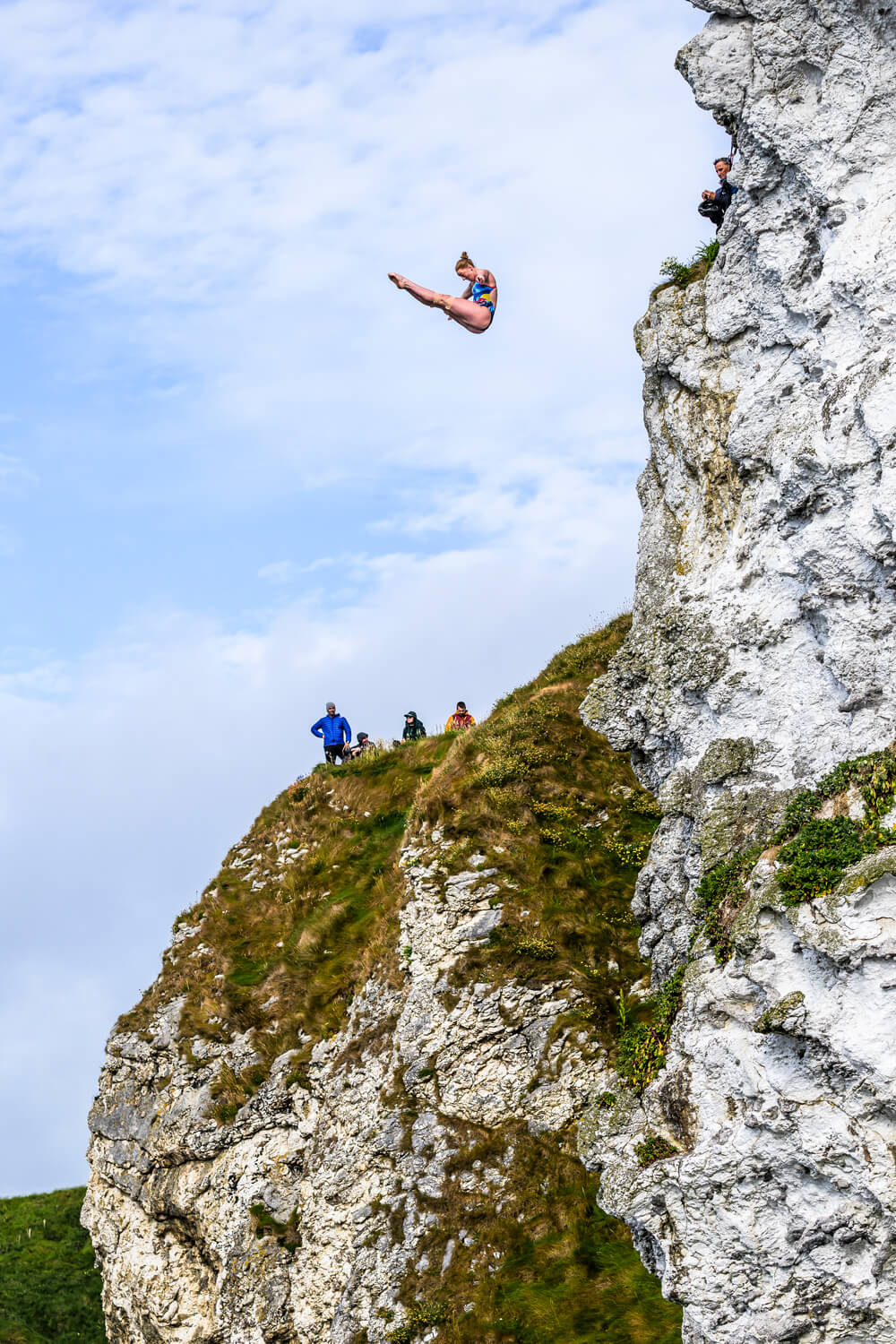
I t was a beautiful June morning in Saint-Raphaël, France, site of the first event of the Cliff Diving World Series’ 2021 season. Carlson was invited to compete as a wildcard. At that point, she had been training for nearly a year from a platform that measured exactly 20-m. above a Montreal pool.
When she and Lapointe first saw the little rock on the French cliff, 23 metres above the wavy ocean, Carlson looked at her coach and said: “Nope, let’s go home.”
“We first sat on the platform at that height and I said, ‘This is way too high, [though] the view is spectacular,”’ Lapointe says. “I told Molly, ‘Right before we left, I told your mom I’m going to take care of you, and I’m not sure I can respect my promises.’”
After a few minutes, they decided Carlson could compete. She talked herself into it like so: “Just do it, girl. Do one, see how you feel.”
She jumped, executing a single forward somersault into a half-twist in a pike position, which she nailed cleanly. Carlson emerged from the water with a giant smile on her face, and says she felt “pretty invincible.” That feeling stayed with her for all her dives; the rookie finished in second place.
Taking the top spot that day was Australian Rhiannan Iffland, the winner of four straight season-ending World Series championships who hadn’t lost a single event in three years. Quickly, the wildcard Carlson was cast as the woman who could at last pressure Iffland. In her second season on tour, Carlson fulfilled that promise, beating Iffland in Boston, the Aussie’s first loss in four years.
Carlson has now beaten Iffland four times in her nearly four seasons, something no one else on the Series has managed even once. Iffland is now up to seven straight season championships. “She is the most consistent person I’ve ever met in my life,” Carlson says of Iffland, adding it takes “perfection” to beat her. When it happens, like it did again earlier this year in Greece, the win brings its own challenges. “She’s putting pressure on herself to do it again,” Lapointe says.
“The struggle after beating her is I’m like, ‘If I ever beat her again, I need to be perfect.’ So I fall back into that perfectionism, because we have the identical degree of difficulty with our dives, so it literally comes down to execution,” Carlson explains. “And if I’m not perfect, then it’s hers every single time. If I mess up one little thing on my first dive, I know Rhiannan’s winning the competition.”
Carlson also still struggles with her self-image, with whether she feels she even deserves to be on top of the podium. “That’s when I start with, ‘Okay, do I look good enough to be world champion? Am I the problem? Am I not world champion because I look a certain way, because my body feels like this right now? Am I too weak to be world champion right now?’” she asks. “There are so many thoughts that go through my anxious brain that make this life even harder.”
Cliff diving is plenty hard enough on its own. The sport is rife with the potential for major injury, given athletes hit the water at upwards of 85 km/h, the reason they enter feet-first. “I’ve gotta say, out of all the sports that we could have chosen, we chose one of the riskiest and most dangerous,” says Carlson’s boyfriend, Aidan Heslop, a top-ranked diver on the circuit himself, who represents the UK. Asked how they cope with the danger, he points to precision and preparation, as well as the safety measures in place at events: on-site ambulances and a helicopter present at competitions. “We make this crazy, risky sport as safe as we possibly can. And people get knocked out, people puncture lungs, but we always have support there,” he says.

Carlson’s heart rate reaches 150 beats-per-minute before she does her tougher dives. Heslop figures his pumps about as fast just watching her. “I’m extremely passionate about her dives, I want her to do so well,” he says. “She’s one of the most consistent divers out there, so I’m never scared for her safety. I’m just kind of nervous for the dive and how the competition will go. It’s a bit stressful watching someone you love do this, but I know she understands the sport and she knows what she’s doing more than most people.”
Carlson suffered her worst injury last June while training in Montreal, when she hit the water nearly chest first. Immediately her ears rang and her head spun, and she was sensitive to light. She took a full month off to heal her concussion, and getting back on the platform was among the scariest things she’s ever done. Again, she documented the whole experience online.
In sharing moments like these with her fans, Carlson is also helping herself. Her six million followers help her to convince herself to keep diving off cliffs. “Every single time they remind me that, ‘Molly, you could come dead last and we are still inspired by you,’” she says. “And I’m like, ‘Oh, I love you guys.’ [The support] just helps so much to do the sport that I do, because when you live with anxiety every day, your No. 1 thing you want to do is run and hide from the situation. So having them help me and be proud of the little things, like when I come third instead of first, they remind me to be grateful and proud.”
Carlson has also grown to appreciate that she’s not just a cliff diver, but also an influencer and content creator. It’s that second part of her professional identity that got her to the Olympic Games in Paris earlier this summer, hired by NBC to show the Games through a different lens. One of her most popular posts was one unrelated to the Games, showing herself bloated while wearing a dress, and sharing that a stranger had asked if she was pregnant. As she explained, her 16-year-old self would’ve gone home “to think of all the ways I could change the way my body looks,” but this time she went home to “remind myself that I am worth so much more than what my body looks like.” As she wrote: “I’m so proud of how I handled this and I hope this video helps someone out there that may also be struggling with body image/bloating.”
Another post, of her bawling during Celine Dion’s opening ceremony performance was shared by Dion herself. “I can officially retire,” Carlson jokes.
If high diving becomes an Olympic sport before she retires from competition, count Carlson in. “I would absolutely love to be there, but there is no longer a need for me to be an Olympian to feel worthy,” she says. Carlson is a member of Canada’s national high diving team, and last year won world championship silver, while her teammates took bronze and fourth place on the women’s side. They’re all in the training group based out of Montreal that started with just Carlson a few years ago. It is now eight deep and includes Heslop, the one non-Canadian.
Another member of that training group is Simone Leathead, who started training in high diving full-time last year, and is now ranked No. 4 among women on the Red Bull circuit. “When I decided I wanted to do this, Molly was just so open and really took me under her wing, and Aidan as well,” Leathead says. “A huge part of my success is because of them, because they really made me feel at home and comfortable and able to showcase my talents. I feel like also, if you want to be the best, you’ve got to surround yourself with the best, and Molly and Aidan are really doing their thing.”
Leathead is from Montreal. She’ll have a big contingent of friends and family in the crowd at the upcoming event at home, but she finds it hard to imagine what the turnout of ‘Bravies’ will look like given what she’s used to seeing halfway around the world. “I knew she had a big fanbase, but earlier this season in New Zealand was a wake-up call,” Leathead says. “Like, it really shook me, the amount of people she touched with her story, and her messages.”
“When we go to competitions it’s always, ‘Molly, Molly, Molly,’ but it’s never been in her home country before,” Lapointe adds. “And you know, high diving has never been as big as it is now, and it’s mainly because of Molly.”
Heslop is so used to the adoration surrounding Carlson that he calls it “a real treat” when a fan approaches and wants to speak to him instead. He figures that happens “about two per cent of the time.” He’s seen it all, but the interaction that stands out came this year in Greece, when he arrived at practice earlier than Carlson and saw a young woman “stunned, looking at me” and then looking all around, “and I knew she was trying to find Molly.”
He was with Carlson about an hour later when they saw the girl again, and she sprinted, full-tilt, at Carlson. “By the time she got to her, her face was just covered in tears — I’ve actually never seen anyone in my life cry like that. She was hyperventilating, and the tears were running down her face like a waterfall,” says Heslop, who pulled out his camera to get some footage “for Molly’s vlog, obviously.”
The young woman barely spoke English but managed to tell Carlson she watches all her videos, and takes the captions and plugs them into Google translate so she can understand the messages. “She’s a platinum-standard Bravie,” Heslop says.
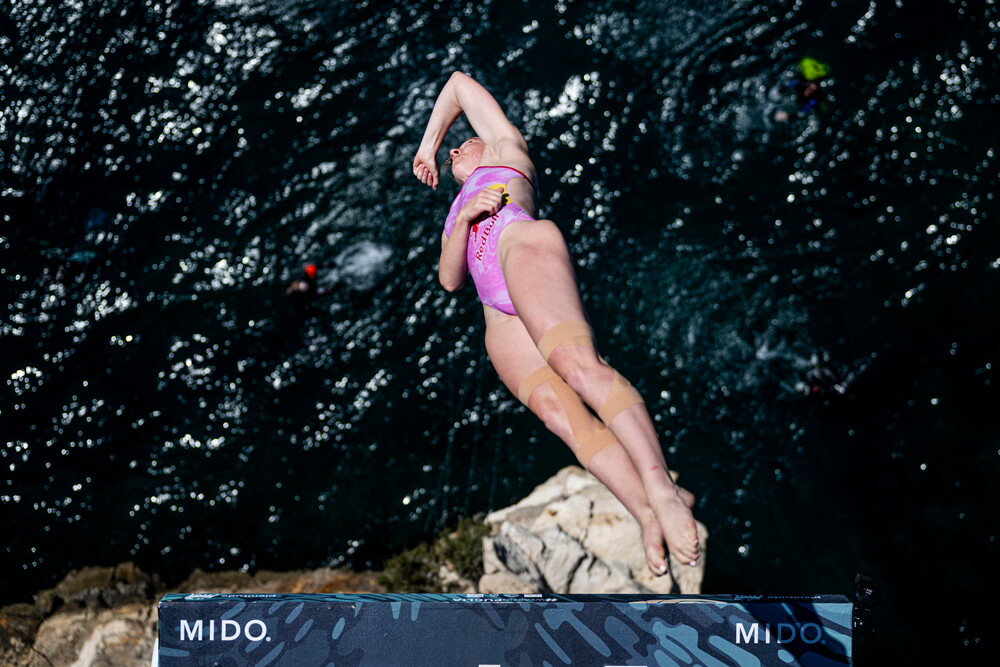
Carlson went on to win that event to open the season. On Aug. 25, Montreal will play host to the sixth event of 2024, which has been Carlson’s most consistent year so far, seeing her land on every podium, including last week in Oslo.
Carlson is known for a front quadruple somersault with a half twist, a dive with one of the highest degrees of difficulty among women on the Series. “She’s always got the pointed toes, the straight legs, the straight arms, the straight fingers extended and all that lot,” Heslop says. “She gets the high scores — she does the hard dives a lot prettier than I do.”
This off-season, starting in November, Carlson’s hoping to get a backwards quadruple somersault competition-ready for 2025 — a dive only one woman on tour has tried in competition so far. “If I can start doing the world’s hardest dive at every event, I think we’ll definitely start seeing some magical results,” she says.
Preparation is especially important as she pushes the boundaries of what she’s doing in the air. “There is a personality, a crazy side that is recognized in this sport that she doesn’t have — she’s more out of her comfort zone than most of the divers, so she has to be very prepared to dive,” Lapointe says. “She is scared and she’s anxious and she doesn’t like to jump off cliffs naturally. But she likes to push herself, mentally, to be stronger in life. Some people don’t confront their out-of-comfort zone, and she goes 100 per cent to hers, which is very impressive.”
“You never feel ready at Red Bull Cliff Diving. So, when you do it anyway and you face those mental battles and you do it, you’re just proving to yourself like, ‘Okay you’re physically ready, it’s just the mental that you have to get over,’” Carlson adds. “That’s truly the bravery I showcase to myself every weekend. Every event is different and brings its own challenges. Sometimes we get a perfect flat platform to jump off for all four dives, but the tide might change and then surprise, it’s higher than you thought and you land on your ass.”
Carlson doesn’t sugarcoat how she’s feeling ahead of her home event. “I’m super anxious,” she admits. “Of course, my brain immediately goes to: I need to land on the podium in my home country. I need to win in Canada.”
She’ll have a crowd of friends and family 75 people deep, plus countless others from her Brave Gang community. “I think I’m just gonna cry on the platform, honestly,” she says.
Carlson is the person that brings the most viewers to her sport. And what she’s most looking forward to about a pro stop in Montreal is giving Canadians and people in her city a chance to see cliff diving live.
“People are going to look outside their window, they’re going to see us jumping from eight storeys high into where these massive cruise ships are going to be, and they’re going to be like, ‘What is happening right now?’” she says.
“We’ll be showing people how much we train for this, because we’re doing the hardest dives in the world and we’re doing them well. And I think that is something to be celebrated. People are going to appreciate the beauty and the art and the difficulty of this sport by seeing it in North America. And I’m so excited, and, oh my God, the popularity is going to explode in Canada!”
